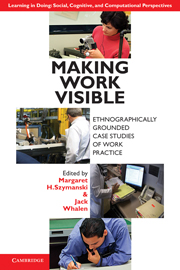Book contents
- Frontmatter
- Contents
- List of Figures and Excerpts
- List of Tables
- List of Contributors
- Series Foreword
- Foreword by John Seely Brown
- Acknowledgments
- Introduction
- Part I Work Practice Study in Historical Context
- Part II Applying Work Practice Methods
- Part III Practices around Documents
- Part IV The Customer Front
- Part V Learning and Knowledge Sharing
- Part VI Competency Transfer
- 18 Fujitsu Learned Ethnography from PARC
- 19 The Work Practice Center of Excellence
- 20 Transferring Ethnographic Competence
- References
- Index
- LEARNING IN DOING: SOCIAL, COGNITIVE AND COMPUTATIONAL PERSPECTIVES
19 - The Work Practice Center of Excellence
Published online by Cambridge University Press: 05 August 2012
- Frontmatter
- Contents
- List of Figures and Excerpts
- List of Tables
- List of Contributors
- Series Foreword
- Foreword by John Seely Brown
- Acknowledgments
- Introduction
- Part I Work Practice Study in Historical Context
- Part II Applying Work Practice Methods
- Part III Practices around Documents
- Part IV The Customer Front
- Part V Learning and Knowledge Sharing
- Part VI Competency Transfer
- 18 Fujitsu Learned Ethnography from PARC
- 19 The Work Practice Center of Excellence
- 20 Transferring Ethnographic Competence
- References
- Index
- LEARNING IN DOING: SOCIAL, COGNITIVE AND COMPUTATIONAL PERSPECTIVES
Summary
In late 2005, a Xerox business group, Creative and Technical Communication (CTC), began to sell its services and solutions to clients outside of Xerox. This transition to the external market would require consulting skills, yet the subject matter experts inside of CTC had very little, if any, experience working with clients other than Xerox. Additionally, because CTC would be a new player in the external market, it needed a distinct way to differentiate itself from its older, more experienced competitors in order to gain traction and increase revenue.
Tom Hurysz, Vice President of CTC, recognized the need to invest in work practice training for his consultants and to establish a center of excellence in his organization that could support their external marketing efforts. Historically, work practice researchers had helped CTC (see Sprague et al., this volume) and other business units with various customer-facing projects; in these engagements, subject-matter experts would work alongside work practice analysts. So Hurysz was familiar with the value of work practice study; and a recent rental car client engagement confirmed the value that work practice could bring (Sprague et al., this volume). Hurysz was quick to champion a work practice study training effort in his organization, stating, “I want work practice study to be a part of the consulting methodology because I think it reveals issues and opportunities that a normal process engineering method is not going to get at” (personal communication, 2008).
- Type
- Chapter
- Information
- Making Work VisibleEthnographically Grounded Case Studies of Work Practice, pp. 336 - 343Publisher: Cambridge University PressPrint publication year: 2011



